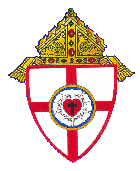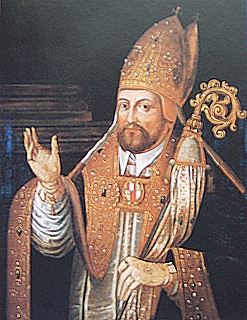A bishop is an ordained, consecrated, or appointed member of the Christian clergy who is generally entrusted with a position of authority and oversight.

In Christianity, an archbishop is a bishop of higher rank or office. In some cases, such as the Lutheran Church of Sweden and the Church of England, the title is borne by the leader of the denomination. Like popes, patriarchs, metropolitans, cardinal bishops, diocesan bishops, and suffragan bishops, archbishops are in the highest of the three traditional orders of bishops, priests, and deacons. An archbishop may be granted the title or ordained as chief pastor of a metropolitan see or another episcopal see to which the title of archbishop is attached.

The Catholic Church, sometimes referred to as the Roman Catholic Church, is the largest Christian church, with approximately 1.3 billion baptised Catholics worldwide as of 2018. As the world's oldest and largest continuously functioning international institution, it has played a prominent role in the history and development of Western civilization. The church is headed by the Bishop of Rome, known as the pope. Its central administration is the Holy See.
A titular see in various churches is an episcopal see of a former diocese that no longer functions, sometimes called a "dead diocese".
An Apostolic administration in the Catholic Church is administrated by a prelate appointed by the Pope to serve as the ordinary for a specific area. The area is not yet a diocese or for a diocese, eparchy or similar permanent ordinariate that either has no bishop or, in very rare cases, has an incapacitated bishop.
A titular bishop in various churches is a bishop who is not in charge of a diocese. By definition, a bishop is an "overseer" of a community of the faithful, so when a priest is ordained a bishop, the tradition of the Roman Catholic and Orthodox churches is that he be ordained for a specific place. There are more bishops than there are functioning dioceses. Therefore, a priest appointed not to head a diocese as its diocesan bishop but to be an auxiliary bishop, a papal diplomat, or an official of the Roman Curia is appointed to a titular see.

The hierarchy of the Catholic Church consists of its bishops, priests, and deacons. In the ecclesiological sense of the term, "hierarchy" strictly means the "holy ordering" of the Church, the Body of Christ, so to respect the diversity of gifts and ministries necessary for genuine unity.
The term secular clergy refers to deacons and priests who are not monastics or members of a religious institute. A diocesan priest is a Catholic, Anglican or Eastern Orthodox priest who commits themself to a certain geographical area and is ordained into the service of the citizens of a diocese, a church administrative region. That includes serving the everyday needs of the people in parishes, but their activities are not limited to that of their parish.
A diocesan bishop, within various Christian traditions, is a bishop or archbishop in pastoral charge of a diocese or archdiocese.

The priesthood is one of the three holy orders of the Catholic Church, comprising the ordained priests or presbyters. The other two orders are the bishops and the deacons. Only men are allowed to receive holy orders, and the church does not allow any transgender people to do so. Church doctrine also sometimes refers to all baptised Catholics as the "common priesthood".

Anointing of the Sick is a sacrament of the Catholic Church that is administered to a Catholic "who, having reached the age of reason, begins to be in danger due to sickness or old age", except in the case of those who "persevere obstinately in manifest grave sin". Proximate danger of death, the occasion for the administration of Viaticum, is not required, but only the onset of a medical condition of serious illness or injury or simply old age: "It is not a sacrament for those only who are at the point of death. Hence, as soon as anyone of the faithful begins to be in danger of death from sickness or old age, the fitting time for him to receive this sacrament has certainly already arrived."

The Augustana Catholic Church (ACC), formerly the Anglo-Lutheran Catholic Church (ALCC) and the Evangelical Community Church-Lutheran (ECCL), is an American church in the Lutheran Evangelical Catholic tradition. The ACC says it is unique among Lutheran churches in that it is of both Lutheran and Anglo-Catholic heritage and has also been significantly influenced by the Roman Catholic Church. The church was founded in 1997 by former members of the Lutheran Church–Missouri Synod. Its headquarters are in Pittsburgh, Pennsylvania. The ACC has long had a policy of seeking union with the Roman Catholic Church and announced in 2011 that it would accept the conditions of Anglicanorum coetibus and join the personal ordinariates as they are established. Later developments on limitations of joining the ordinariate caused the ACC to hold their offer while they established intercommunion with groups such as the Old Roman Catholic Church of North America. The church claims a membership in excess of 60,000 in 12 countries.

The Diocese of Rome is the ecclesiastical district under the direct jurisdiction of the pope, who is bishop of Rome as well as the supreme pontiff and leader of the Catholic Church. As the Holy See, the papacy is a sovereign entity with diplomatic relations, and civil jurisdiction over the Vatican City State located geographically within Rome. The Diocese of Rome is the metropolitan diocese of the Province of Rome, an ecclesiastical province in Italy. The first bishop of Rome was Saint Peter in the first century. The incumbent since 13 March 2013 is Pope Francis.

Precedence signifies the right to enjoy a prerogative of honor before other persons; for example, to have the most distinguished place in a procession, a ceremony, or an assembly, to have the right to express an opinion, cast a vote, or append a signature before others, to perform the most honorable offices.
A personal ordinariate, sometimes called a "personal ordinariate for former Anglicans" or more informally an "Anglican ordinariate", is a canonical structure within the Catholic Church established in accordance with the apostolic constitution Anglicanorum coetibus of 4 November 2009 and its complementary norms. The ordinariates were established in order to enable "groups of Anglicans" to join the Catholic Church while preserving elements of their liturgical and spiritual patrimony. They are juridically equivalent to a diocese, "a particular church in which and from which exists the one and unique Catholic Church", but may be erected in the same territory as other dioceses "by reason of the rite of the faithful or some similar reason".

This is a glossary of terms used within the Catholic Church.

There are seven sacraments of the Catholic Church, which according to Catholic theology were instituted by Jesus and entrusted to the Church. Sacraments are visible rites seen as signs and efficacious channels of the grace of God to all those who receive them with the proper disposition. The sevenfold list of sacraments is often organized into three categories: the sacraments of initiation, consisting of Baptism, Confirmation, and the Eucharist; the sacraments of healing, consisting of Penance and Anointing of the Sick; and the sacraments of service: Holy Orders and Matrimony.
A particular church is an ecclesiastical community of faithful headed by a bishop, as defined by Catholic canon law and ecclesiology. A liturgical rite depends on the particular church the bishop belongs to. Thus "particular church" refers to an institution, and "liturgical rite" to its practices.

The following outline is provided as an overview of and topical guide to the Catholic Church:













